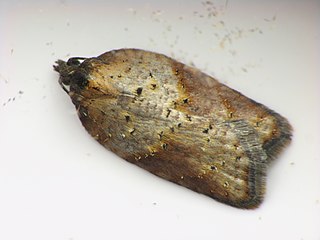
The Tortricidae are a family of moths, commonly known as tortrix moths or leafroller moths, in the order Lepidoptera. This large family has over 11,000 species described, and is the sole member of the superfamily Tortricoidea, although the genus Heliocosma is sometimes placed within this superfamily. Many of these are economically important pests. Olethreutidae is a junior synonym. The typical resting posture is with the wings folded back, producing a rather rounded profile.

Isochorista ranulana is a species of moth of the family Tortricidae. It is found in Australia, where it has been recorded from New South Wales and the Australian Capital Territory.

Stictea is a genus of moths belonging to the subfamily Olethreutinae of the family Tortricidae.

Strepsicrates is a genus of moths belonging to the subfamily Olethreutinae of the family Tortricidae.
Asterolepis is a genus of moths belonging to the subfamily Tortricinae of the family Tortricidae.

The Tortricini are a tribe of tortrix moths.
The Bactrini are a tribe of tortrix moths.

The Olethreutini are a tribe of tortrix moths.

Stictea macropetana, the eucalyptus leafroller, is a moth of the family Tortricidae. It is native to Australia, but is an introduced species in New Zealand, where it was first recorded in 1921. It was first described by Edward Meyrick in 1881.

Hadronyche infensa, the Darling Downs funnel-web spider, is a venomous mygalomorph spider, one of a number of Australian funnel-web spiders found in Queensland and New South Wales.
Stictea glaucothoe is a moth of the family Tortricidae. It was described by Edward Meyrick in 1927. It is found on Fiji and Samoa.
Stictea ejectana, the guava bud moth, is a moth of the family Tortricidae. It was described by Francis Walker in 1863. It is found on Fiji, Samoa, the Marquesas Archipelago, Tahiti, Rapa Iti, the southern Mariana Islands, the Philippines and in New Caledonia, New Zealand and Australia.
"Capua" tetraplasia is a species of moth of the family Tortricidae. It is found in Australia, where it has been recorded from Queensland.
Epiphyas aulacana is a species of moth of the family Tortricidae. It is found in Australia, where it has been recorded from Lord Howe Island, New South Wales, South Australia, Victoria and Tasmania. The habitat consists of open forests where it has been recorded at altitudes between sea level and 300 meters in Tasmania.
Syllomatia xythopterana is a species of moth of the family Tortricidae. It is found in Australia, where it has been recorded from New South Wales, Victoria and Tasmania. The habitat consists of open forests.
Stictea coriariae is a species of moth of the family Tortricidae. It is found in China, Russia and Japan.
Merophyas immersana is a species of moth of the family Tortricidae. It is found in Australia, where it has been recorded from New South Wales, Victoria and Tasmania. The habitat consists of open areas, including pastures.

Stictea mygindiana is a moth belonging to the family Tortricidae. The species was first described by Michael Denis and Ignaz Schiffermüller in 1775.

Ichneutica infensa is a moth of the family Noctuidae. This species is endemic to New Zealand. It is found throughout the North and South Islands but appears to be rarely seen or collected in the north and west parts of the North Island. As at 2019 the northern limit to the range of this species is Titirangi. I. infensa inhabits tussock grasslands and native forest. Larvae are nocturnal and its host plants are in the genus Carex including Carex solandri. Larvae have also been raised on Bromus catharticus. Adults of this species are on the wing from late October to February. Adults are narrow winged with patterns on the forewings that are relatively distinctive. However this species can possibly be confused with I. inscripta.
Ichneutica inscripta is a moth of the family Noctuidae. This species is endemic to New Zealand. This species is found from south Auckland to Taranaki in the North Island. It prefers to inhabit dense native forest with high rainfall at higher altitudes. The life history of this species is unconfirmed as are the host species of its larvae but is likely to be similar to its close relative I. infensa. This species is very similar in appearance to its close relative I. infensa but has more strongly patterned forewings. The adults of this species are on the wing from late October to January.









